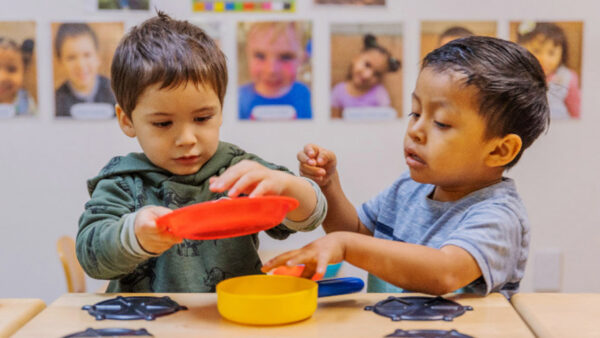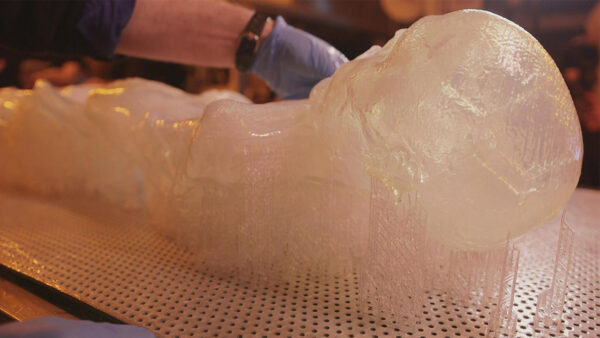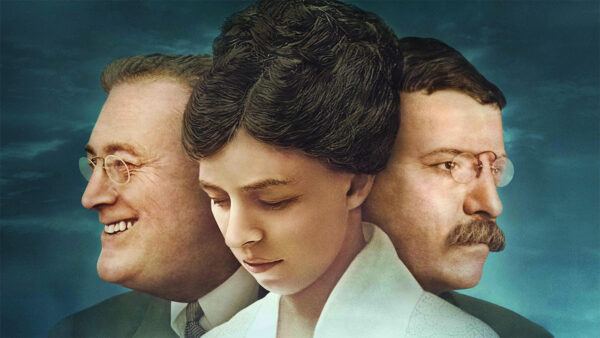Many parents underestimate how much their young children can do when it comes to cooking, but by tailoring activities to your child’s abilities and interests, the kitchen can be a great place to expand learning in many subject areas. We rounded up a few fun things you can do in the kitchen with your early learners. The activities range from recipes that inspire curiosity and creativity to crafts that will keep kids busy and learning alongside you while you’re preparing dinner. Use the Guided Learning questions below as conversation starters to encourage critical thinking and reflection.
Science
The kitchen offers many opportunities for lessons in basic chemistry. You can talk about how ingredients change as they are combined, melted, or baked. Introduce topics like changing phases of matter by demonstrating how chocolate chips melt into a liquid state and turn back into a solid state once cooled. You can talk about how some changes, such as baking a cake (or burning one), can never be undone!
When you’re busy in the kitchen, PBS KIDS for Parents suggests a fun way for your child to explore the concept of sound. Lay out some pots and pans along with wooden and metal spoons. Encourage them to make different sounds with their “instruments.” Find more ideas in PBS KIDS for Parents’ collection of activities to explore light and sound with young children.
Guided Learning
- Which utensil makes the loudest sound?
- How does the size or the material of the pot change the pitch of the sound?
Recommended for ages 2-4
Level of assistance: Independent
Math
Math is everywhere in the kitchen — kids can learn from measuring ingredients, counting teaspoons, and keeping track of time. For example, this simple recipe for Rainbow Fruity Frozen Yogurt Bark by Eats Amazing allows children to easily mix and count ingredients while decorating their creations with colorful fruit. Mixing together greek yogurt and honey can be a great way for young children to develop their fine motor skills.
Guided Learning
- As you get your blueberries, strawberries, and any other toppings you want to put on the bark, make it an exercise in counting. Ask your child how many of each topping they want and count them out into separate bowls. When you’re ready to put them on the bark, count out the toppings again.
- What happens if you put more honey than the recipe recommends
- How does that change the taste?
- After you put the bark in the freezer, set a timer so that you can count down how much time is left until your yummy treat is ready!
Recommended for ages 3-6
Level of assistance: Parent supervision needed
Reading
To bring books to life, make real-world connections with the characters, lessons learned, and even food featured in the story. Pick a favorite book that features food such as “Cloudy with a Chance of Meatballs” by Judi Barrett or “Pancakes, Pancakes!” by Eric Carle. As you look through the pictures, have your child pick a dish to make together. Look up the recipe online or use one of our suggestions below.
- Classic Spaghetti and Meatballs by PBS Food
- Fluffy Blueberry Pancakes by PBS Food
- Check out these tips from Epicurious on cooking with your preschooler.
Guided Learning
- As you prepare the dish, talk about the role of the food in the book. Why was this food important in the story? Who ate it?
- Talk about the similarities and differences between the dish you made and the one in the book.
- Practice descriptive language by describing tastes, smells, colors and textures. What happens to the ingredients as you heat up the stove? What does it sound like?
Recommended for ages 3-8
Level of assistance: Parent supervision needed
Arts
Preparing dinner can be a busy job, or even stressful, with the added duty of entertaining your toddler. Simple crafts can be a great way to give your child something to do without much supervision required, and they’re great for 2- to 3-year-olds who aren’t old enough to actively help with dinner-making tasks. They also serve as a great opportunity for older siblings to guide their younger brother or sister’s learning.
Have your children get started on making dessert while you’re starting on dinner. This recipe for Milk Paint by Epicurious uses sweetened condensed milk, food coloring and plain sugar cookies or toast. Stir 2-4 drops of food coloring into ¼ cup of condensed milk. Repeat with other colors in separate bowls. Paint the milk onto the toast or cookies to make a dessert that will be ready to eat after dinner.
Guided Learning
- Older siblings can help by encouraging little siblings to mix colors or draw pictures and shapes on the toasts.
- Ask questions and make predictions. What happens when you mix a swipe of yellow milk with blue milk?
Recommended for ages 2-4
Level of assistance: Independent or with help from older siblings
This article was originally published on PBS SoCal’s At-Home Learning initiative.






















